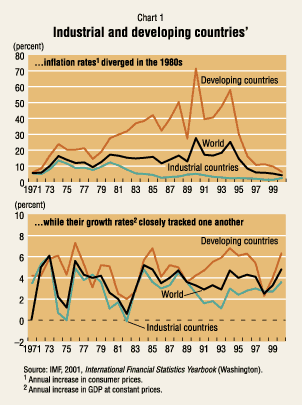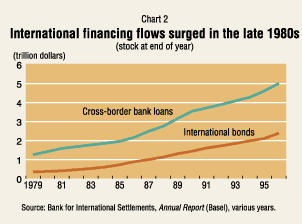 About F&D Subscribe Back Issues Write Us Copyright Information Free Email Notification Receive emails when we post new
items of interest to you. |
Globalization and the Silent Revolution of the 1980s James M. Boughton During the 1980s, as many countries sought to adapt to a changing, sometimes turbulent economic climate, their policymakers underwent a dramatic change in thinking. How beneficial has this "silent revolution" been, and what can policymakers and the international community do now to broaden and secure the gains it has brought? What were the 1980s all about? There is, of course, no reason that decades should have personalities, any more than we should expect the position of the stars at the time we are born to influence our lives. Nonetheless, characterizing decades—think of the Gay Nineties or the Roaring Twenties, or try to talk about the 1930s without mentioning the Great Depression—has a hold on our imaginations not unlike that of astrology. For anyone who cares about international economic policy, the 1990s were the decade of globalization, when international trade in goods, services, and financial capital became more widespread than ever before. The 1970s were the decade of instability, floating exchange rates, and rising oil prices. Between them, the 1980s are hard to focus on. During the decade, economic policymaking in industrial countries moved sharply to the right under the political leadership of Masayoshi Ohira and his successors in Japan, Margaret Thatcher in the United Kingdom, Ronald Reagan in the United States, and Helmut Kohl in Germany. "New classical" and supply-side economics provided the theoretical rationale for bold, if sometimes misguided, policy experiments. And for much of the developing world, the 1980s were thought of at the time as the "lost decade," when living standards stagnated or fell year after year. The 1980s also saw the IMF come of age as a participant in the international financial system. Under the Bretton Woods system of fixed but adjustable exchange rates (1946-73), the IMF played a subsidiary role to the few industrial countries that provided the capital and managed the system. It was the system that mattered, much more than the institution. When that structure collapsed, those same countries devised a strategy for restoring stability under which the IMF would exercise "firm surveillance" over member countries' exchange rate policies, but they left it to the next generation of leaders to figure out what that phrase might mean in practice. Not until the early 1980s did the IMF make the majority of its lending conditional on implementation of detailed macroeconomic policy reform programs. Not until the international debt crisis of 1982 did the IMF assume its modern responsibilities as a financial crisis manager. Those two developments interacted to give the institution a greatly enhanced role. As a unifying theme for the world economy in the 1980s, consider the idea of a silent revolution in economic policymaking: a subtle but ultimately dramatic drift throughout the decade and throughout much of the world toward policies that were more cooperative, outward oriented, and market friendly than before. It seemed silent because it occurred piecemeal, with no obvious starting or completion point, but it was nonetheless revolutionary in its effects. Without it, the globalization of the 1990s could not have proceeded as it did. Why a "silent revolution"? Michel Camdessus, as Managing Director of the IMF, used the phrase "silent revolution" in 1989 to characterize the transformation that was taking place in a number of developing countries. Speaking at the Annual Meetings of the Boards of Governors of the IMF and the World Bank, he noted how countries were taking the "painful decision" to strengthen their economic policies and implement growth-oriented adjustment programs with financial support from the IMF. What was revolutionary was that many countries that earlier had resisted the IMF's policy advice and changed their policies only as much as was necessary to qualify for financial assistance were now willingly embracing market- and export-oriented policies. Although such policies have been popularized as the "Washington consensus," the neoliberal perspective was neither unique nor original to Washington. Longstanding ideological divisions between those favoring development of private enterprise and those insisting on a primary development role for state enterprise, and between those favoring open and unified market pricing and those insisting on widespread controls, were gradually being resolved in favor of economic liberals in many parts of the world. The collapse of the Soviet Union in 1991 put a very emphatic exclamation point on this victory. Debating whether this was really a revolution or an evolutionary process is a tempting game to play, but it should not distract us from examining what was actually happening. Economic philosophies and prevailing attitudes toward policymaking changed dramatically during the 1980s. In the new classical economics that became the prevailing philosophy in the 1980s, the government is expected to play an indirect role in guiding the economy and creating the preconditions for sustainable growth but not to assume direct responsibility for ensuring full employment or high economic growth. Few governments would have adopted that view in the 1970s, but many did by the end of the 1980s. In such low-income countries as Ghana, Tanzania, Uganda, and Zimbabwe, the silent revolution ushered in a new age of cooperation with the IMF. In such emerging markets as China, Korea, Mexico, and Poland, it fostered entrepreneurship independent of the state. And throughout the industrial world, short-term stabilization policies gave way to longer-term strategies aimed at containing inflation and deregulating private economic activity. Ramifications of the revolution These developments dramatically affected the world economy. Perhaps the most notable achievement was the virtual end of inflation as an international phenomenon. Although the average world inflation rate showed little change, the problem became more and more concentrated in a few developing countries with extremely high rates. For the aggregate of industrial countries, consumer price inflation fell from a peak of more than 12 percent in 1980 to 2½ percent in 1986 and then remained subdued throughout the 1990s (Chart 1). That drop was purchased at the cost of sharp declines in output and employment in the early 1980s, but policymakers generally held fast and eschewed the countercyclical stimulative policies that they had favored in the 1960s and 1970s.  By the middle of the decade, growth had resumed in most industrial countries. For developing countries, however, the picture was far less bright. While prices of manufactured goods stabilized, prices of the primary commodities on which most developing countries depend for export revenues fell precipitately. By the end of the decade, the drop in commodity prices had become the most severe in modern history. Consequently, although the average growth rate in developing countries was reasonably good throughout the decade (around 4 percent), that growth was heavily concentrated in the newly industrializing economies of Asia. In Latin America and sub-Saharan Africa, sustained growth proved elusive. If the wringing out of inflation and the global opening up of markets were expected to strengthen economic growth, most of the benefits still lay in the future. The 1980s also profoundly altered the world financial system. The massive instabilities of the late 1970s and early 1980s—large external imbalances accompanied by real fluctuations in reserve-currency exchange rates of 50 percent or more—forced a reassessment of investment and policy strategies. The chaotic realignments of exchange rates and persistently large external imbalances of the first half of the 1980s inspired the major industrial countries to try to develop more cooperative policy strategies. That shift was most evident in Europe, where exchange rate stabilization and economic cooperation were guiding principles. Among the key-currency countries of Europe, North America, and Asia (Japan), efforts to stabilize exchange rates started in January 1985 with a sudden burst of coordinated official interventions in exchange markets. It continued that same year with a high-level and highly publicized meeting at the Plaza Hotel in New York and climaxed in February 1987 with a meeting at the Louvre in Paris. Although these attempts at formal policy coordination petered out after a few years, finance ministers and central bank governors continued to look for cooperative rather than uncoordinated responses to external shocks. More dramatically, when large international banks decided in 1981-82 that some developing countries might not be able to continue to service their external debts, they suddenly stopped rolling over short-term credits and forced a debt crisis of unprecedented sweep. Globally, the growth rate of international bank lending declined sharply. Within a few years, nearly 20 countries in Europe, Africa, and Latin America had experienced one or more debt crises, requiring intervention by the IMF and other multilateral agencies. The case-by-case strategy for resolving these crises, with the IMF in a central coordinating role, proceeded in three stages. From 1982 to 1985, the focus was on "concerted lending," which linked the approval of IMF financial assistance to agreements by commercial bank syndicates to increase their credit exposure to the country. When this seminal effort at "private sector involvement" ran out of steam, the focus shifted in late 1985 to the Baker Plan (named after then U.S. Treasury Secretary James A. Baker III). This second phase aimed to restore economic growth in the most heavily indebted countries with support from coordinated lending by banks, the IMF, and the multilateral development banks. When that strategy failed and creditors realized that the afflicted countries would never spontaneously grow their way out of the debt crisis, official creditors turned to direct debt-reduction techniques, culminating in the Brady Plan of 1989 (named after Baker's successor, Nicholas Brady). A combination of debt reduction, the silent revolution in policymaking, and lower world interest rates ushered in a resumption of international financial flows (Chart 2) and brought the crisis to a close. 
What resulted from this rather mixed record of economic successes and failures was an equally mixed record in the 1990s. Both the overall stabilization of price levels and the corresponding depression in world commodity markets have continued to this day. The shift in economic priorities in industrial countries from trying to maintain high employment to first maintaining stable prices has been judged by its proponents to be a success and shows every sign of enduring. From this pattern, some countries have gained, while others have lost. Moreover, the ongoing transformation in policymaking—the silent revolution—in combination with the resolution of the debt crisis and the continued expansion of international financial markets paved the way for the globalization of the 1990s. Countries that succeeded in putting their external debt service on a sustainable path and that were able to develop more outward-looking economic policies generally saw their exports and economic growth increase. As international investors recognized these improvements, many emerging markets experienced a surge of capital inflows. Those inflows, however, turned out to be unstable and highly sensitive to changing economic conditions. A series of financial crises characterized the second half of the 1990s. Learning from history A decade after the crest of the silent revolution, what lessons can be drawn? In particular, how should the architecture of the international financial system evolve so as to maximize the benefits while minimizing the drawbacks of a liberal and globalized economic order? Four points stand out. First, macroeconomic stability and structural reform are both prerequisites for success in an open economy, and a failure in either domain can bring down the other. In a simpler age, it may have seemed that fiscal or monetary excess was "always and everywhere" the proximate cause of an economic crisis, but we now know that structural rigidity or inadequate regulation of markets is just as dangerous. If the IMF is to focus its surveillance on the consistency of exchange rate and macroeconomic policies—as it traditionally has done, and as its mandate dictates—then it will need to strengthen its collaboration with the World Bank and other multilateral agencies to ensure that all potential pitfalls are covered. Second, as more and more countries develop open, market-oriented economic and political systems, cooperation and mutual respect between official creditors and borrowers become ever more important. This requirement implies that governments must be prepared to take ownership of—that is, assume the primary responsibility for—effective economic policies and that multilateral agencies must be flexible enough to permit ownership to develop. Third, effective oversight of the international financial system requires broad agreements on the conduct of economic policy. IMF surveillance was hampered in the 1980s by the absence of such agreements, as countries or groups of countries experimented with a variety of economic policy strategies. The world no longer has a system of stable exchange rates that can define and anchor macroeconomic policies, but it is now evolving toward agreements on standards that could potentially serve that function. That process effectively began in 1994, when the Interim Committee on the International Monetary System issued its Madrid declaration, calling on all countries to adopt sound domestic policies and embrace international economic cooperation and integration. Through the Madrid declaration, the world's finance ministers in effect endorsed the key elements of the silent revolution. Since then, the Governors and the Executive Board of the IMF have taken steps to implement that policy, including by adopting and applying specific standards on data dissemination (the IMF's Special Data Dissemination Standard and General Data Dissemination System), the soundness of banking systems (the Basel Committee's Core Principles for Effective Banking Supervision), and fiscal transparency (the IMF's Code of Good Practices on Fiscal Transparency). Fourth, stability of cross-border financial flows is essential if globalization is to be generally beneficial, but this stability is a moving target because private financial markets are constantly adapting to new circumstances. The debt strategies developed in the 1980s could not have effectively addressed the financial crises of the 1990s, and the experience of the 1990s can only hint at viable solutions for problems that may arise in the future. Just as the Bretton Woods system succumbed to the pressure of volatile financial flows in the early 1970s and gave way to the search for "firm surveillance," whatever strategy is devised next for limiting the effects of modern financial crises will have only a limited shelf life. Eventually, the 1980s will be seen as a positive step in the course of economic progress. The expansion of international trade, the stabilization of monetary and fiscal policies in many countries, the establishment of a more systemic role for the IMF, the successful resolution of the debt crisis and the first tentative moves toward debt relief for low-income countries, and above all the silent revolution in policymaking around the world—all these are bound to be beneficial for most groups in most countries in the long run. Right now, however, cyclical effects dominate our view, even when we look back over the postwar era. The growing prosperity of countries recovering from World War II upset the old order in which one or a few countries succeeded far more than others. That led to financial pressures in the 1960s, a series of economic and financial crises in the next three decades, and controversies about the effects of globalization as the century ended. The challenge for the next half-century is to dampen those cycles and broaden the range of those who benefit, without sacrificing the upward economic trend. This article is based in part on the author's book The Silent Revolution: The International Monetary Fund 1979-1989 (Washington: International Monetary Fund, 2001).
|